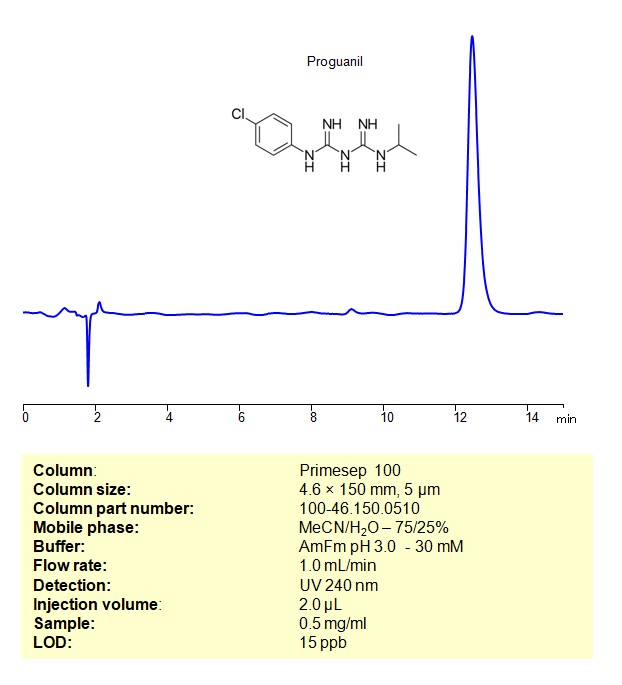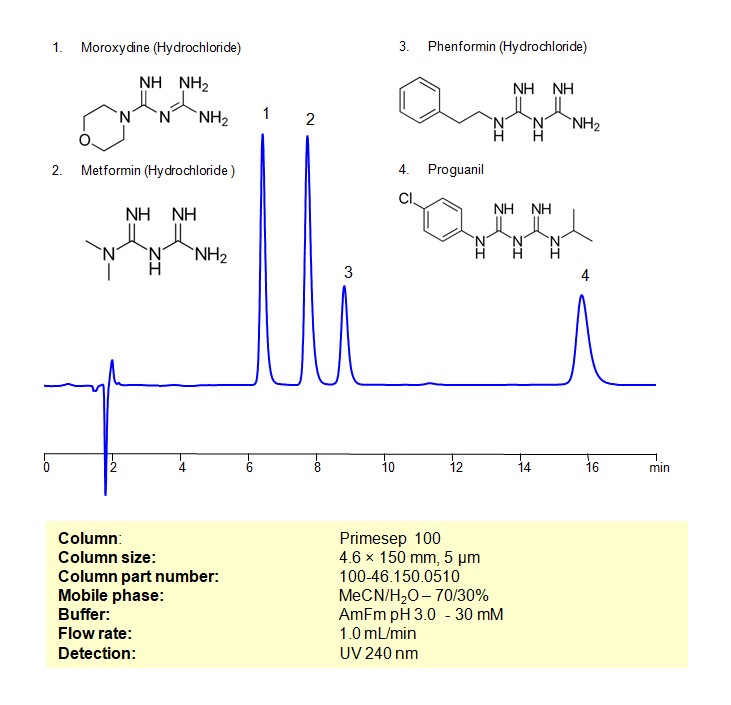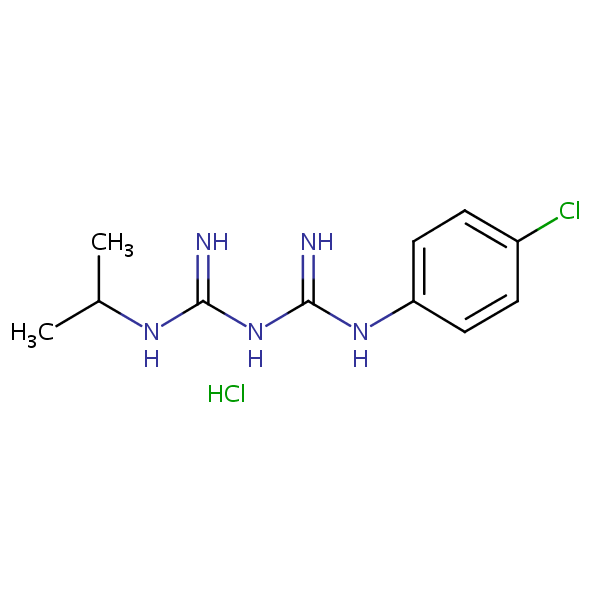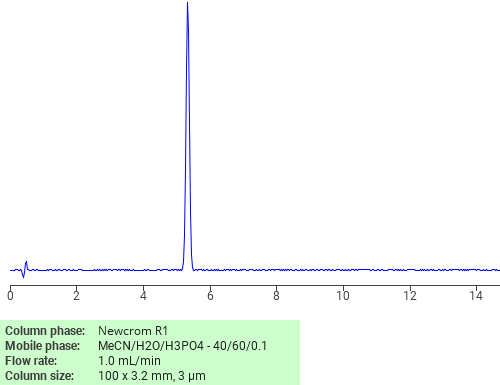| CAS Number | 637-32-1 |
|---|---|
| Molecular Formula | C11H17Cl2N5 |
| Molecular Weight | 290.191 |
| InChI Key | SARMGXPVOFNNNG-UHFFFAOYSA-N |
| LogP | 2.35 |
| Synonyms |
|
Applications:
HPLC Method for Analysis of Proguanil on Primesep 100 Column
February 1, 2024
High Performance Liquid Chromatography (HPLC) Method for Analysis of Proguanil hydrochloride on Primesep 100 by SIELC Technologies
Separation type: Liquid Chromatography Mixed-mode SIELC Technologies

High Performance Liquid Chromatography (HPLC) Method for Analysis of Proguanil hydrochloride
Biguanides, including Moroxydine, Metformin, Proguanil, and Phenformin, are a group of organic compounds that share a common structural feature, namely the presence of two guanidine groups.
Proguanil is an antimalarial medication often used in combination with other drugs, such as atovaquone. It is used for both prevention and treatment of malaria. Proguanil is a prodrug, and its active form inhibits the development of the malaria parasite in the liver.
These biguanides exhibit various pharmacological activities, and while some are primarily used for antidiabetic purposes, others have applications in antiviral or antimalarial treatments. It’s important to note that the safety and efficacy of these drugs depend on proper medical supervision and adherence to prescribed dosages.
Proguanil can be retained and analyzed using a Primesep 100 mixed-mode stationary phase column. The analysis employs an isocratic method with a simple mobile phase comprising water, acetonitrile (MeCN), and ammonium formate as a buffer. This method allows for detection using UV at 240 nm
| Column | Primesep 100, 4.6 x 150 mm, 5 µm, 100 A, dual ended |
| Mobile Phase | MeCN/H2O 75/25% |
| Buffer | AmFm pH 3.0 – 30 mM |
| Flow Rate | 1.0 ml/min |
| Detection | UV 240 nm |
| Samples | 0.5 mg/ml |
| Injection volume | 2 µl |
| LOD* | 8 ppb |
| Class of Compounds | Biguanides |
| Analyzing Compounds | Proguanil hydrochloride |
Application Column
Primesep 100
Column Diameter: 4.6 mm
Column Length: 150 mm
Particle Size: 5 µm
Pore Size: 100 A
Column options: dual ended

HPLC Method for Separation Biguanides such as Moroxydine, Metformin, Proguanil and Phenformin on Primesep 100 Column
February 1, 2024
High Performance Liquid Chromatography (HPLC) Method for Analysis of Moroxydine, Metformin, Proguanil and Phenformin on Primesep 100 by SIELC Technologies
Separation type: Liquid Chromatography Mixed-mode SIELC Technologies

High Performance Liquid Chromatography (HPLC) Method for Analysis of Moroxydine , Metformin, Proguanil and Phenformin
Biguanides, including Moroxydine, Metformin, Proguanil, and Phenformin, are a group of organic compounds that share a common structural feature, namely the presence of two guanidine groups.
Moroxydine:
- Moroxydine is an antiviral medication used in the treatment of influenza. It is believed to inhibit the early stages of viral replication.
Metformin:
- Metformin is an oral antidiabetic medication used to treat type 2 diabetes. It works by reducing glucose production in the liver and improving insulin sensitivity in peripheral tissues. Metformin is one of the most widely prescribed drugs for diabetes management.
Proguanil:
- Proguanil is an antimalarial medication often used in combination with other drugs, such as atovaquone. It is used for both prevention and treatment of malaria. Proguanil is a prodrug, and its active form inhibits the development of the malaria parasite in the liver.
Phenformin:
- Phenformin is an antidiabetic biguanide that was previously used to treat type 2 diabetes. However, due to the risk of lactic acidosis (a serious side effect), it has been largely withdrawn from the market in many countries.
These biguanides exhibit various pharmacological activities, and while some are primarily used for antidiabetic purposes, others have applications in antiviral or antimalarial treatments. It’s important to note that the safety and efficacy of these drugs depend on proper medical supervision and adherence to prescribed dosages.
Biguanides such as Moroxydine , Metformin, Proguanil and Phenformin be retained, separated and analyzed using a Primesep 100 mixed-mode stationary phase column. The analysis employs an isocratic method with a simple mobile phase comprising water, acetonitrile (MeCN), and ammonium formate as a buffer. This method allows for detection using UV at 240 nm
| Column | Primesep 100, 4.6 x 150 mm, 5 µm, 100 A, dual ended |
| Mobile Phase | MeCN/H2O 70/30% |
| Buffer | AmFm pH 3.0 – 30 mM |
| Flow Rate | 1.0 ml/min |
| Detection | UV 240 nm |
| Samples | 1. 0.1 mg/ml 2. 0.1 mg/ml 3. 0.1 mg/ml 4. 0.1 mg/ml |
| Injection volume | 10 µl |
| LOD* | 1. 7 ppb 2. 7 ppb 3. 17 ppb 4. 18 ppb |
| Class of Compounds | Biguanides |
| Analyzing Compounds | Metformin, Proguanil hydrochloride, Phenformin, Moroxydine |
Application Column
Primesep 100
Column Diameter: 4.6 mm
Column Length: 150 mm
Particle Size: 5 µm
Pore Size: 100 A
Column options: dual ended
Moroxydine
Phenformin
Proguanil hydrochloride

Separation of Proguanil hydrochloride on Newcrom R1 HPLC column
May 16, 2018
Proguanil hydrochloride can be analyzed by this reverse phase (RP) HPLC method with simple conditions. The mobile phase contains an acetonitrile (MeCN), water, and phosphoric acid. For Mass-Spec (MS) compatible applications the phosphoric acid needs to be replaced with formic acid. Smaller 3 µm particles columns available for fast UPLC applications. This liquid chromatography method is scalable and can be used for isolation impurities in preparative separation. It also suitable for pharmacokinetics.
Application Column
Newcrom R1
The Newcrom columns are a family of reverse-phase-based columns. Newcrom A, AH, B, and BH are all mixed-mode columns with either positive or negative ion-pairing groups attached to either short (25 Å) or long (100 Å) ligand chains. Newcrom R1 is a special reverse-phase column with low silanol activity.
Select options



